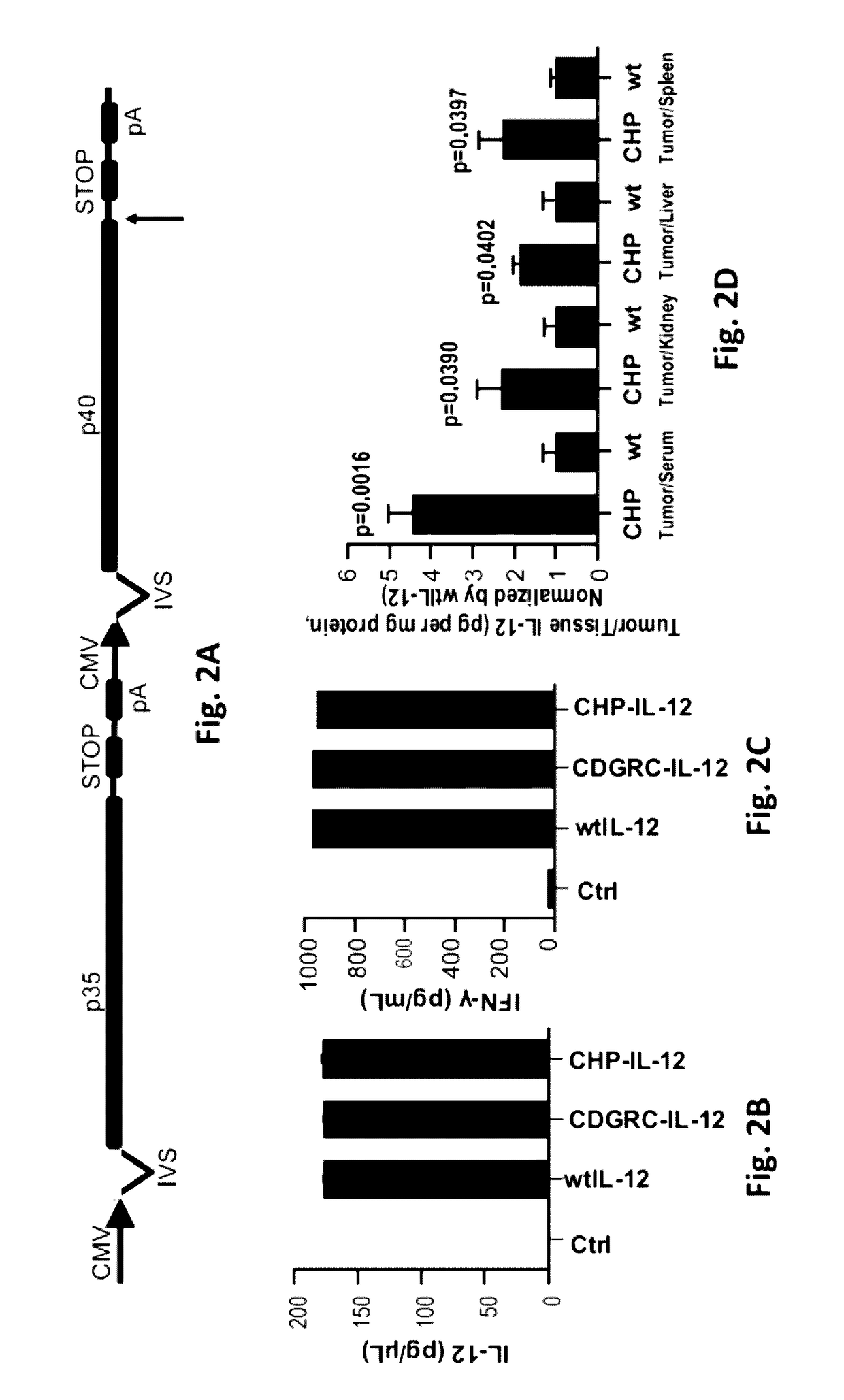Carcinoma homing peptide (CHP), its analogs, and methods of using
a homing peptide and carcinoma technology, applied in the field of carcinoma homing peptide and its analogs, can solve the problems of increasing immunogenicity, toxicity, and cost of treatment, and reducing the reputation and potential application of this effective cytokine, so as to reduce lung metastasis, prolong survival, and inhibit tumor growth
- Summary
- Abstract
- Description
- Claims
- Application Information
AI Technical Summary
Benefits of technology
Problems solved by technology
Method used
Image
Examples
example 1
Materials and Methods
[0055]Plasmid DNA Preparation.
[0056]All SEAP gene constructs were generated via direct PCR as previously described [13]. The wild type IL-12 gene construct (wtIL-12) was obtained from Valentis, Inc. (San Francisco, Calif.) [34], and gene sequences encoding the peptide sequences were inserted directly prior to the stop codon of the IL-12 p40 subunit encoding region using the primer sequences listed in Table 2, below. The wtIL-12 plasmid includes both the p35 and p40 subunits. The control plasmid DNA (control) consisted of a deletion of the IL-12 gene from the IL-12 construct. All plasmid DNAs were manufactured with the Qiagen (Alameda, Calif.) EndoFree plasmid preparation kit.
[0057]Cell Lines, In Vitro Gene Transfer, and IFN-γ Induction.
[0058]CT26 (colon cancer), SCCVII (squamous cell carcinoma), 4T1 (breast carcinoma), EMT6 (breast cancer), and B16F10 (skin melanoma) cell lines were obtained from American Type Culture Collection (ATCC, Manassas, Va.), the AT84 (...
example 2
CHP Increases Accumulation of the Fusion Reporter Gene Product and Biotin-CHP Conjugate into Tumors
[0084]Several fusion gene constructs were cloned by inserting peptide encoding DNA sequences directly prior to the stop codon in a secreted alkaline phosphatase (SEAP) reporter plasmid DNA (FIG. 1A) using primers of Table 2 [13]. These peptide-SEAP fusion gene constructs were delivered via intramuscular (i.m.) electroporation (EP) of the anterior tibialis muscles in mice bearing tumors located 1 cm craniodorsal of the tail. After 72 hours, tumors and serum were collected and analyzed for SEAP distribution. It has been shown that inserting peptides into the SEAP plasmid can alter SEAP activity but not protein production [20]. To compensate for the altered SEAP activity, we used the ratio of the SEAP activity between tumors and serum (T / S SEAP). The un-corrected values for the tumor and serum SEAP activities are shown in FIG. 7A and FIG. 7B.
[0085]FIG. 1A shows the peptide-SEAP constructs...
example 3
CHP-IL-12 Gene Product Maintains Targeting and Biological Functions
[0088]Peptide-IL-12 fusion gene constructs were generated by inserting the peptide coding sequences directly before the stop codon of the p40 subunit in an IL-12 plasmid DNA (FIG. 2A) [20]. CHP-IL-12, CDGRC-IL-12, wtIL-12, or empty vector plasmid DNA were transfected into 4T1 cells. After 24 hours, equivalent levels, approximately 175 pg / μL, of the IL-12p70 heterodimer were detected in the medium of all three IL-12 gene plasmid DNA transfected cells, and negligible IL-12p70 was detected in the control wells (FIG. 2B). Transferring the IL-12 containing medium to splenocytes induced similar levels of IFN-γ, a hallmark of IL-12 function (FIG. 2C) indicating that these fusion IL-12 proteins possess the same biological function as wtIL-12.
[0089]The distribution of CHP-IL-12 in the tumor, kidney, liver, and serum was determined via IL-12p70 ELISA 72 hours after treating CT26 tumor-bearing IL-12 knockout Balb / c (IL-12− / −) m...
PUM
| Property | Measurement | Unit |
|---|---|---|
| volume | aaaaa | aaaaa |
| concentration | aaaaa | aaaaa |
| diameter | aaaaa | aaaaa |
Abstract
Description
Claims
Application Information
 Login to View More
Login to View More - R&D
- Intellectual Property
- Life Sciences
- Materials
- Tech Scout
- Unparalleled Data Quality
- Higher Quality Content
- 60% Fewer Hallucinations
Browse by: Latest US Patents, China's latest patents, Technical Efficacy Thesaurus, Application Domain, Technology Topic, Popular Technical Reports.
© 2025 PatSnap. All rights reserved.Legal|Privacy policy|Modern Slavery Act Transparency Statement|Sitemap|About US| Contact US: help@patsnap.com



